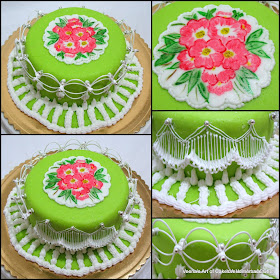My son calls it the upside down cake. The first time I did it he looked so worried that my cake was upside down but was equally fascinated to see the string - "mama look how their standing up... kept telling everybody mama's making a fun cake"
Well, as promised here I share with you the pictures of my Extension work.
A word of warning, don't do this technique on a windy day, and definitely not if you have kids around. (just kidding). I had both a windy day and both my kids around. It's passover vacations now for two weeks.
As I mentioned in my previous post. This is not a dummy.
It's a 6" cake with Yellow Cake recipe, vanilla buttercream and home made sugar paste.
For Royal Icing Extension Work
- you first make a paper template and mark the spaces for the scallop you want to pipe. You could pipe these scallops all around the cake or in small sections.
- next you pipe scallops around the cake sides making sure the scallops do not touch the bottom of your cake.
- You continue to build up on the scollops by over piping letting each scallop dry before you pipe another.
- Once you have about 6 to 10 rows of scallops it looks like a bridge around your cake.
- You should let this bridge dry completely first.
- Once dry, using a fine tip you pipe strings from the sides of your cake to the edge of your bridge.
- You could pipe the strings straight, slanted or an an angle depending on the design your want to achieve. The spacing should be no wider than the width of the strings you are piping.
- The smaller the tip and the closer the strings; the more delicate your extensions will look.
Here is the Royal Icing consistency for the bridge work I did. As you can see I prefer it stiff rather than a piping consistency. I find it holds better.
This is my first scallop.
Make sure the first row touches the cake for support or it will collapse.
You could use a damp or dry brush for this. A damp brush will moisten and blend the lines. A dry brush will define the lines.
Here are two rows of scallops. If you doing it around the whole cake by the time you come around to the first, it would have dried. Here I'm doing only three so I did have to wait for a few minutes before I over piped.
Here is a close up of the first two rows.
Here are four rows of scallops
Here is a close up of 7 rows.. see how they build up? It is important that you let them dry in between.... ask me how I know....?
I did a total of 8 rows of scallops. This is shinny so you know it's still wet.
This bridge has to be thoroughly dry or it will not hold the weight of the strings.
The next morning.. completely dry bridge. As you can see I worked on the cake border and board.
Here is the Royal Icing Consistency for the string work.
Thinner than the bridge work; so it will come out of the tip 1; but also hold itself and not collapse into the cake.
If the string falls into the cake it means the icing is too wet.
If the piping curls when you press on the bag it means the icing is too stiff.
In the beginning, getting the right consistency looks like a challenge but a few practices and you will get the hang of it.
Start piping strings. I'm using a Wilton No 1.
The spacing between the strings should be really small. As you can see mine are not as close so I re-did them a bit more closer. However, I took these pictures and not those, so I'm posting these for you.
I preferred to start from the center outwards but you could do it otherwise too.
Here you can see I re-did the strings a bit closer.
And here I finished all three scallops
Add more details to finish your design.
And here are the final strings.
With that I showed you both the techniques I used on this cake. Oriental String work as well as Royal Icing Extensions work.
Well, I do hope you learned something from this post.
Thanks for stopping by.

I was just gazing at this incredible cake all time.The detailing of the design is unique and incredible.Now that's creative!The piping design is Phenomenal..Practice really pays.
ReplyDelete